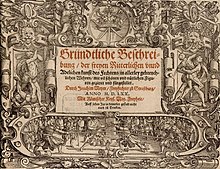Joachim Meyer
Joachim Meÿer | |
|---|---|
fechtbuch | |
| Notable works | Gründtliche Beschreibung der Kunst des Fechtens (1570) MS A.4°.2 (1560) MS Var.82 (1570-71) |
| Spouse | Appolonia Ruhlman |
| Signature | |
Joachim Meyer (ca. 1537–1571) was a self-described
(in English, Thorough Descriptions of the Art of Fencing) first published in 1570.Works

In 1570, Joachim Meyer wrote a comprehensive, multi-weapon treatise entitled .
Meyer's system generally flows from, and uses the terminology of, the
Meyer's book itself consists of detailed explanatory text describing the guards or postures (huten) for each weapon, cuts, footwork and specific and often quite complex plays or devices (stücke), accompanied by a series of finely executed
Life
Meyer's book was reprinted in 1600 in Augsburg, and became a highly influential source for other 16th- and 17th-century German fencing books, including the aforementioned book by Jacob Sutor and a book from 1672 by an Italian, Theodor Verolinus. Both versions were simplified redactions of Meyer's more detailed work. Meyer is mentioned in a brief Latin treatise on martial arts by Heinrich von Gunterrodt (1579) and is also the only German among the famous masters listed in the late 17th century fencing treatise by Giuseppe Morsicato Pallavicini.[1]
Little is known about Meyer himself. Some information on Meyer's life has come to light as a result of recent scholarship (Dupuis). "Originally from
References
External links
- Die Freifechter A partial transcription of the first (1570) printing.
- https://web.archive.org/web/20160808115319/http://www.freifechter.com/ International Fencing Guild with a mission to educate people on the efficacy and art of Medieval & Renaissance martial arts.
